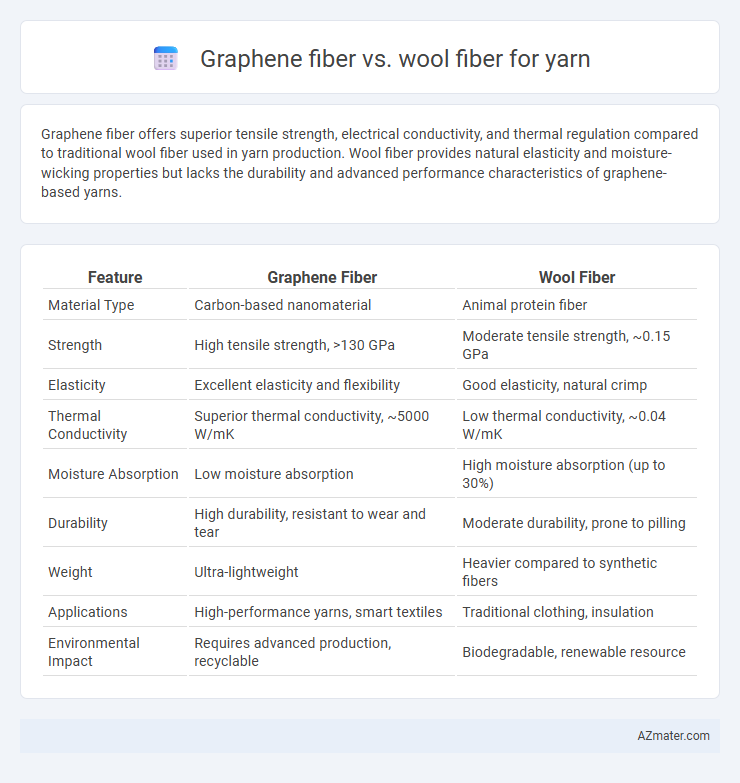Graphene fiber offers superior tensile strength, electrical conductivity, and thermal regulation compared to traditional wool fiber used in yarn production. Wool fiber provides natural elasticity and moisture-wicking properties but lacks the durability and advanced performance characteristics of graphene-based yarns.
Table of Comparison
| Feature | Graphene Fiber | Wool Fiber |
|---|---|---|
| Material Type | Carbon-based nanomaterial | Animal protein fiber |
| Strength | High tensile strength, >130 GPa | Moderate tensile strength, ~0.15 GPa |
| Elasticity | Excellent elasticity and flexibility | Good elasticity, natural crimp |
| Thermal Conductivity | Superior thermal conductivity, ~5000 W/mK | Low thermal conductivity, ~0.04 W/mK |
| Moisture Absorption | Low moisture absorption | High moisture absorption (up to 30%) |
| Durability | High durability, resistant to wear and tear | Moderate durability, prone to pilling |
| Weight | Ultra-lightweight | Heavier compared to synthetic fibers |
| Applications | High-performance yarns, smart textiles | Traditional clothing, insulation |
| Environmental Impact | Requires advanced production, recyclable | Biodegradable, renewable resource |
Introduction to Graphene and Wool Fibers
Graphene fiber, derived from single layers of carbon atoms arranged in a hexagonal lattice, exhibits exceptional strength, electrical conductivity, and thermal properties, making it a revolutionary material for advanced yarn applications. Wool fiber, sourced from the fleece of sheep, offers natural insulation, moisture-wicking capabilities, and elasticity, widely valued for comfort and durability in textile manufacturing. The contrast between graphene's high-tech, synthetic nature and wool's organic, renewable origins defines their distinct roles in innovative and traditional yarn production.
Composition and Structure Comparison
Graphene fiber, composed of a single layer of carbon atoms arranged in a hexagonal lattice, offers exceptional tensile strength, electrical conductivity, and thermal stability compared to wool fiber, which is primarily made of keratin proteins forming a helical, crimped structure. Wool's natural composition includes scales and a porous cortex that provide elasticity, moisture retention, and insulation, whereas graphene fibers present a smooth, conductive surface with minimal moisture absorption. The nanoscale carbon framework of graphene fibers results in lightweight, high-performance yarns ideal for advanced applications, while wool fibers deliver natural warmth and breathability suited for traditional textile uses.
Mechanical Strength and Durability
Graphene fiber exhibits superior mechanical strength compared to wool fiber, boasting tensile strength up to 10 times greater, making it highly resistant to stretching and tearing. Wool fibers offer natural elasticity and moderate strength but degrade faster under mechanical stress due to their protein-based structure. The durability of graphene fiber ensures prolonged lifespan in yarn applications, resisting wear, abrasion, and environmental factors more effectively than traditional wool fibers.
Thermal Conductivity and Insulation
Graphene fiber exhibits significantly higher thermal conductivity compared to wool fiber, allowing for rapid heat dissipation and enhanced temperature regulation in yarn applications. Wool fiber provides superior natural insulation due to its crimped structure and air-trapping properties, effectively retaining heat and maintaining warmth in cold environments. Combining graphene's thermal conductivity with wool's insulating characteristics can result in advanced hybrid yarns that optimize thermal management for smart textiles and performance wear.
Moisture Wicking and Breathability
Graphene fiber excels in moisture wicking and breathability due to its high thermal conductivity and hydrophobic properties, which rapidly disperse sweat and enhance air circulation. Wool fiber naturally absorbs moisture while maintaining breathability, providing excellent temperature regulation by trapping air within its crimped structure. Compared to wool, graphene fiber offers superior drying speed and cooling effects, making it ideal for performance yarn in activewear.
Flexibility and Comfort in Wearables
Graphene fiber offers exceptional flexibility due to its thin, strong carbon lattice, enabling yarns to bend and stretch without losing durability, making it ideal for high-performance wearables. Wool fiber provides natural elasticity and softness, enhancing comfort by insulating and wicking moisture, which supports all-day wearability. Combining graphene's resilience with wool's thermal regulation can produce advanced yarns that optimize both flexibility and comfort in wearable textiles.
Environmental Impact and Sustainability
Graphene fiber exhibits a significantly lower environmental impact compared to traditional wool fiber due to its production process, which consumes less water and energy and generates fewer greenhouse gas emissions. Unlike wool, which involves animal farming that contributes to land degradation, methane emissions, and high water usage, graphene fibers are synthetic and can be manufactured with scalable, eco-friendly methods. The durability and recyclability of graphene fiber enhance sustainability by reducing waste and extending the lifecycle of yarn products in the textile industry.
Applications in the Textile Industry
Graphene fiber offers exceptional strength, lightweight properties, and conductivity, making it ideal for smart textiles and high-performance athletic wear compared to traditional wool fiber. Wool fiber excels in insulation, moisture-wicking, and natural elasticity, suited for thermal clothing and luxury fashion textiles. The textile industry leverages graphene fiber for advanced functional fabrics, while wool remains preferred for comfort and durability in classic apparel.
Cost and Accessibility Considerations
Graphene fiber yarn offers superior strength and conductivity but remains significantly more expensive and less accessible than traditional wool fiber, which is widely available and cost-effective for mass production. Wool fiber benefits from established global supply chains and renewable sourcing, making it a preferred choice for affordable textile manufacturing. The high cost of graphene fiber limits its use primarily to specialized, high-performance applications rather than everyday apparel or large-scale textile industries.
Future Prospects of Graphene vs Wool Yarns
Graphene fiber offers superior strength, conductivity, and durability compared to traditional wool fiber, positioning it as a groundbreaking material for future yarn innovations. Its lightweight and antimicrobial properties could revolutionize performance textiles, especially in sportswear and smart fabrics, where wool's natural insulation and moisture-wicking abilities remain valuable but limited. As graphene manufacturing scales, the integration of graphene yarns may surpass wool in versatility, sustainability, and technological applications, driving a shift in the textile industry's material preferences.

Infographic: Graphene fiber vs Wool fiber for Yarn
 azmater.com
azmater.com